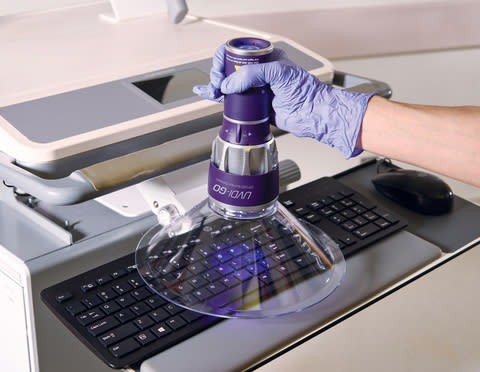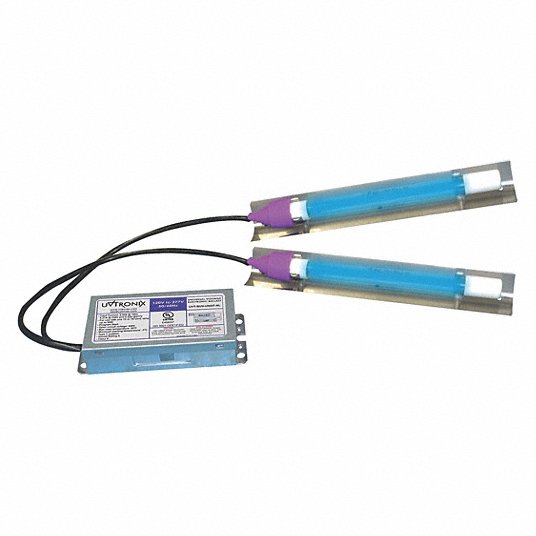Discovering the Perks of Far-UVC Innovation in UV Sanitizers: A Total Introduction
Wiki Article
Much UVC Light: A Game-Changer in the Fight Versus Airborne Pathogens
In the ever-evolving battle versus airborne pathogens, the development of much UVC light has stimulated significant rate of interest and potential. What exactly is much UVC light, and how does it work?The Science Behind Far UVC Light
The scientific principles underlying making use of Far UVC light as a prospective remedy for combating airborne virus are both intricate and promising. Much UVC light describes a certain series of ultraviolet (UV) light wavelengths, generally in between 207 and 222 nanometers, which have been found to efficiently kill or inactivate microorganisms such as microorganisms and infections. Unlike standard UVC light, which has a shorter wavelength and is understood for its germicidal homes but can likewise damage human skin and eyes, Far UVC light has been revealed to be risk-free for human exposure.The vital mechanism behind the performance of Far UVC light lies in its capacity to pass through and ruin the hereditary material of bacteria, including their DNA and RNA. When revealed to Far UVC light, the genetic material undertakes a process called photodimerization, where nearby bases in the DNA or RNA particle bind together, stopping duplication and making the bacterium not able to recreate or trigger infection.

Exactly How Much UVC Light Works
Much UVC light operates by utilizing certain ultraviolet wavelengths to successfully neutralize bacteria and prevent their duplication, making it an appealing option for combating airborne virus. Unlike standard UVC light, which is dangerous to human skin and eyes, much UVC light has shorter wavelengths, generally in the series of 207 to 222 nanometers (nm), that do not pass through the external layer of the skin or the tear layer of the eye. This makes it secure for constant human direct exposure, while still being lethal to microorganisms and viruses.The efficiency of much UVC light hinge on its capacity to destroy the dna and permeate and RNA of bacteria. When exposed to far UVC light, the hereditary product of these microorganisms is harmed, making them incapable to replicate and infect cells. Additionally, research studies have shown that far UVC light can successfully inactivate air-borne infections, such as flu, measles, and coronaviruses, including SARS-CoV-2, the virus in charge of COVID-19.
Additionally, far UVC light is likewise qualified of disinfecting surface areas and things in an enclosed room. By mounting much UVC light components or utilizing portable much UVC light tools, it is possible to continuously decontaminate the air and surfaces, reducing the threat of airborne transmission of microorganisms.
Advantages of Far UVC Light
Using far UVC light offers a variety of significant advantages in combating air-borne pathogens and guaranteeing a much safer setting for continual human direct exposure. One of the key benefits of far UVC light is its capability to properly counteract various kinds of hazardous germs, infections, and fungis without causing damage to human beings. Unlike standard UV light, which can be dangerous to human skin and eyes, far UVC light has a shorter wavelength that allows it to target and damage pathogens while presenting marginal risk to human health.
In addition, far UVC light is much safer for the atmosphere compared to traditional disinfection methods. Chemical disinfectants often include unsafe active ingredients that can have unfavorable influence on the environment. Far UVC light, on the other hand, does not generate any kind of damaging by-products or residues, making it a more environment-friendly and lasting option.
Applications of Far UVC Light
One of the key usages for much UVC light remains in the area of air filtration and sanitation. Far UVC light has actually shown to be efficient in getting rid of airborne virus such as infections, fungis, and germs. This innovation works by releasing a certain wavelength of light that is qualified of penetrating the outer layers of microorganisms and damaging their DNA, rendering them inactive and incapable to recreate. Unlike standard UV light, far UVC light is safe for human direct exposure, making it suitable for constant usage in public areas such as hospitals, offices, and view website institutions.Another application of far UVC light is in the health care market. It can be utilized to sanitize hospital rooms, operating theaters, and medical equipment, lowering the danger of healthcare-associated infections. In addition, far UVC light can be incorporated right into HVAC systems to detoxify the air flowing in buildings, providing an included layer of defense versus air-borne pathogens.
In addition, far UVC light can be made use of in the food sector to avoid foodborne health problems. It can be utilized to sanitize food processing facilities, killing microorganisms and various other microorganisms that may contaminate food.
Future Implications of Far UVC Light
The prospective future applications of much UVC light are huge and hold promise for numerous markets and sectors. Centers and healthcare facilities might use far UVC light to decontaminate client rooms, running theaters, and waiting locations, decreasing the threat of healthcare-associated infections.In addition, the use of much UVC light in public areas such as airports, train terminals, and shopping center could aid regulate the spread of airborne pathogens. By continuously disinfecting these locations, the risk of transmission could be substantially i loved this reduced, offering a more secure setting for people.
One more potential application of far UVC light is in the food sector. Much UVC light could be utilized to disinfect food prep work surface areas, packaging materials, and storage space locations. This could help avoid the contamination of Click This Link food and minimize the incident of foodborne health problems.
Additionally, far UVC light could be made use of in cooling and heating systems to decontaminate the air circulating in structures. This might be particularly advantageous in jampacked areas such as movie theaters, colleges, and workplaces, where the risk of airborne transmission is higher.
Final Thought
In final thought, much UVC light has emerged as a game-changer in the fight versus airborne virus. Its distinct buildings and ability to safely kill bacteria and infections make it an encouraging service for numerous applications. From public areas to healthcare setups, far UVC light deals numerous advantages in reducing the transmission of illness. With further study and growth, its widespread implementation might have considerable effects for the future of infection control.
Much UVC light refers to a specific range of ultraviolet (UV) light wavelengths, usually in between 207 and 222 nanometers, which have actually been located to properly kill or suspend microorganisms such as microorganisms and viruses. far-uvc. Unlike conventional UVC light, which has a shorter wavelength and is recognized for its germicidal residential or commercial properties however can likewise hurt human skin and eyes, Far UVC light has been revealed to be risk-free for human exposure
Unlike traditional UVC light, which is hazardous to human skin and eyes, much UVC light has shorter wavelengths, commonly in the range of 207 to 222 nanometers (nm), that do not pass through the outer layer of the skin or the tear layer of the eye. Unlike traditional UV light, which can be hazardous to human skin and eyes, much UVC light has a shorter wavelength that permits it to target and ruin microorganisms while presenting very little threat to human wellness.
Unlike conventional UV light, much UVC light is safe for human direct exposure, making it appropriate for continual usage in public areas such as workplaces, schools, and medical facilities.
Report this wiki page